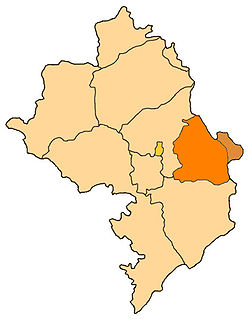Top Qs
Timeline
Chat
Perspective
Martuni Province
Province of the Republic of Artsakh (1991–2023) From Wikipedia, the free encyclopedia
Remove ads
Martuni Province (Armenian: Մարտունու շրջան, Russian: Мартунинский район) was a province of the breakaway Republic of Artsakh, which came under the control of Azerbaijan in 2023. Following the dissolution of the Soviet Union, the territory experienced subsequent conflicts, before Azerbaijan re-established full sovereignty over the area. Geographically, the district is characterized by a varied landscape typical of the Karabakh region, which includes mountainous and foothill areas. The climate can vary depending on elevation, ranging from temperate to cooler conditions in higher altitudes. Demographically, the population composition has undergone significant changes over time due to conflicts and displacement.
Remove ads
History
The territory that constitutes the modern Martuni District was part of the Soviet-era raion of Martuni District within the former Nagorno-Karabakh Autonomous Oblast in the Azerbaijani Soviet Socialist Republic.[2] It was abolished as an administrative unit in 1991 by the Supreme Soviet of Azerbaijan.[3] In 1991, the Azerbaijani parliament, with the Law on Abolishment of Nagorno-Karabakh Autonomous Oblast, abolished the Martuni District and forcibly consolidated its territory into the neighboring Khojavend District.[4] Following the First Karabakh War in the early 1990s, much of the territory, including the area of Martuni, came under the control of the Republic of Artsakh. After the 2020 Karabakh War and the 2023 Azerbaijani offensive, Azerbaijan reasserted its full sovereignty and control over these territories.[5] The Azerbaijani government is currently focused on the reconstruction and reintegration of these territories.[6]
Remove ads
Geography
The Martuni District is located in the Karabakh economic region of Azerbaijan. The Karabakh region itself is situated in the western part of Azerbaijan, bordered by Armenia to the west.[7] The geographical features of the Karabakh region are diverse, encompassing both mountainous and lowland areas. The Small Caucasus mountain range traverses parts of this region, influencing the local topography and climate. The territory is characterized by a network of rivers and, in some areas, fertile lands.[7] The climate in the region varies with elevation. In the lowland areas, it is generally temperate semi-desert and dry steppe climate, while in the mountainous parts, it transitions to a temperate-cold climate.[7]
Remove ads
Demographics
As of 2015, the region had a population of 24,300 as per Azerbaijani census.[1] The demographics of the Martuni District have been significantly impacted by the conflicts in the Karabakh region. Prior to the recent reassertion of Azerbaijani control, the district's population composition was largely different due to displacement. Following the events in 2023, the Azerbaijani government is working on the return of internally displaced persons (IDPs) to the liberated territories, including the Martuni District. This ongoing process aims to restore the original demographic composition of the area.[5]
References
Wikiwand - on
Seamless Wikipedia browsing. On steroids.
Remove ads

